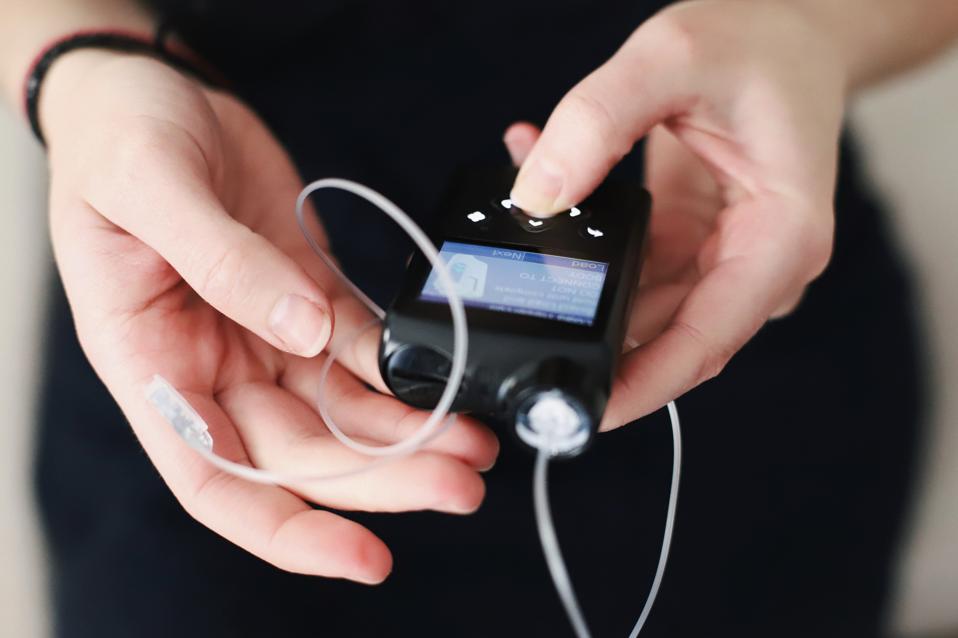Tens of thousands of people with type 1 diabetes in England will be offered ‘artificial pancreas’ devices that help regulate their blood sugar automatically.
Consisting of an insulin pump, a continuous glucose monitor and an algorithm, this ‘hybrid closed loop’ technology reduces the amount of input needed by the individual.
But those using the devices will still have to type in information about their food intake.
They’re nicknamed ‘artificial pancreases’ as they are designed to mimic the usual behavior of that organ. In most people, the pancreas automatically releases a hormone called insulin to keep their blood sugar at the right level.
People with type 1 diabetes no longer produce their own insulin, usually because their immune system has mistakenly attacked their pancreas.
Depending on their particular regimen, many people with type 1 diabetes correct high blood sugar levels by calculating and delivering doses of insulin.
They may also take the hormone when they eat foods containing carbohydrate, and to compensate for the constant release of glucose by the liver. Many factors, including exercise, stress and even the temperature can affect the way insulin works in the body, making it hard to dose correctly.
Both high and low blood sugar can be dangerous in the short term and over time. Low blood sugar can cause numerous physical symptoms and make individuals confused and disorientated. In severe cases, it can cause loss of consciousness and even coma. If a person has low blood sugar frequently — even if it is milder — they may get fewer noticable symptoms, putting them at risk of more serious hypoglycaemia.
High blood sugar can become very dangerous quite quickly. If glucose levels are high for an extended period of time, this can lead to a condition called ketoacidosis, which causes nausea, vomiting, stomach pain and can be deadly without treatment.
Persistent high blood sugar also damages the body in the long run. It can eventually lead to serious problems with the eyes, the nerves, the heart and the kidneys, as well as other organs.
Hybrid closed loop systems can help people with type 1 diabetes better manage their glucose levels and reduce the amount of calculations they have to make on a daily basis. The devices can also help prevent hypoglycaemia by reducing insulin delivery as levels start to fall.
Who will get the devices?
The devices were previously piloted by 835 adults and children. Now the hope is to give them to tens of thousands more.
There are just under 270,000 people living with type 1 diabetes in England, most of whom won’t all be offered the technology right away. But the goal is for everyone eligible to be offered the devices within 5 years.
For now, this means people with type 1 diabetes who are under 18, pregnant, or with an HbA1c (an indicator of average glucose levels over time) of 58 mmol/mol (7.5%) or higher.,
The country’s public health system has set aside £2.5 million for the initial rollout of the tech, which will be delivered by local public health bodies.
A ‘Landmark Moment’
England’s national clinical director for diabetes, Clare Hambling, called the devices “groundbreaking.” She said in a statement: “This transformative technology holds the power to redefine the lives of those with type 1 diabetes, promising a better quality of life as well as clinical outcomes.”
National speciality advisor, Partha Kar, added: “This futuristic technology not only improves medical care but also enhances the quality of life for those affected.”
Collette Marshall, chief executive of charity Diabetes UK, said it was “incredibly exciting” to see the technology rolled out.
“Diabetes is a tough and relentless condition, but these systems make a significant, life-changing difference – improving both the overall health and quality of life for people with diabetes,” she said in a statement.
“This really is a landmark moment and we’ll be working with the NHS and others to ensure a fair rollout that reaches people as quickly as possible.”

